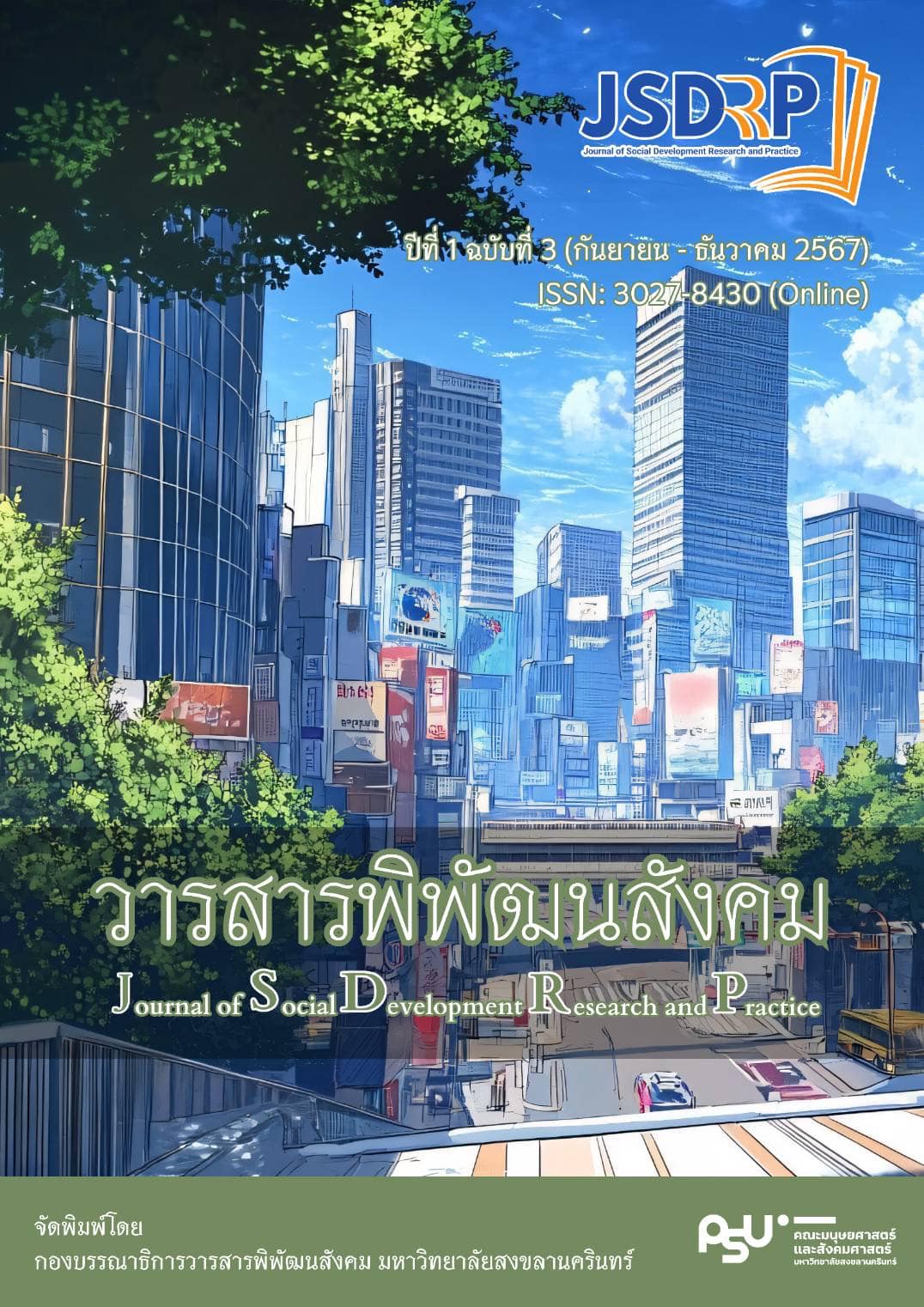Logistics Management to Develop Seafood Tourism Routes in Nakhon Si Thammarat Province
Keywords:
Logistics management, Tourism, SeafoodAbstract
Purpose: Focus on logistics systems that support seafood tourism in Nakhon Si Thammarat province, including identifying problems and challenges from the perspectives of both tourists and operators. This encompasses aspects such as the flow of information, physical transportation, and payment systems used in key tourist areas.
Methodology: This research employs a quantitative study approach, collecting data through questionnaires and in-depth interviews. The target population consists of tourists utilizing restaurant services in Khanom, Tha Sala, and Sichon districts of Nakhon Si Thammarat province. The sample size is determined to be 384 participants, selected through simple random sampling. The sample includes entrepreneurs involved in the tourism and restaurant businesses in the specified areas. Statistical methods used for data analysis include percentage, mean, and standard deviation.
Findings: Tourists visiting Khanom, Tha Sala, and Sichon districts in Nakhon Si Thammarat province, totaling 384 individuals, were predominantly female, under 20 years of age, holding a bachelor’s degree, and with an income ranging from 5,000 to 10,000 Baht. They preferred consuming local cuisine for lunch. Data analysis considered the environment influenced by internal and external factors. The analysis revealed that the potential and readiness of establishments, the identity of seafood dishes, the quality of seafood, the value for money, and the characteristics of service providers were rated at the highest level. A comparison of personal factors with physical flow, information flow, and financial flow indicated statistically significant differences at the 0.05 level.
Applications of this study: Tourism operators should invest in online marketing and promotion through social media, as well as develop digital maps and service information to enhance tourists' access to information. Improving or expanding public transportation routes to be more convenient and accessible will help address issues related to traveling to tourist destinations.
References
กฤติเดช อนันต์. (2561). แนวทางการสร้างความจงรักภักดีต่อการท่องเที่ยวเชิงอาหารของประเทศไทยผ่านคุณค่าเชิงประสบการณ์. วารสารวิทยาศาสตร์และเทคโนโลยีไทย, 8(6), 585–595.
ชนิศา มณีรัตนรุ่งโรจน์, พัชรี ทองคำ, กนกวรรณ มัติโก, พงศกร ไพรโต, พิชามญชุ์ ชูพุดซา และศศิศรัณย์ ฉัตรคำภู. (2562). โลจิสติกส์การท่องเที่ยวที่มีผลต่อความพึงพอใจของนักท่องเที่ยวที่อุทยานแห่งชาติเขาใหญ่. วารสารสหศาสตร์, 18(2), 184-209
เทิดชาย ช่วยบํารุง. (2549). ชุดโครงการวาระแห่งชาติเพื่อการพัฒนาและจัดการการท่องเที่ยวสู่การพัฒนาเศรษฐกิจและสังคมอย่างยั่งยืน. กรุงเทพฯ: สถาบันวิจัยเพื่อพัฒนาการท่องเที่ยว.
ธนาคารกรุงเทพ. (2562). กินเพื่อเข้าใจวิถีพื้นเมือง. สืบค้นเมื่อ 10 กรกฎาคม 2567 จาก https://www.bangkokbanksme.com/en/food-tourism-lifestyle
ธานนิทร์ ศิลป์จารุ. (2552). การวิจัยและวิเคราะห์ข้อมูลทางสถิติด้วย SPSS. พิมพ์ครั้งที่ 10. กรุงเทพฯ: บิสซิเนสอาร์แอนด์ดี.
บุญเลิศ จิตตั้งวัฒนา. (2548). อุตสาหกรรมการท่องเที่ยว.กรุงเทพฯ: เพรส แอนด์ ดีไซน์.
พฤกษ์ จันทนโรจน์. (2566). การส่งเสริมการท่องเที่ยวโดยใช้อาหารไทยในฐานะทรัพยากร Soft Power. เอเชียปริทัศน์, 44(2), 99-132.
ไพรัช พิบูลย์รุ่งโรจน์. (2552). การจัดการโลจิสติกส์สำหรับการท่องเที่ยว: อะไร ทำไม และอย่างไร. สืบค้นเมื่อ 10 กรกฎาคม 2567 จาก https://pairach.com/2011/07/14/why_tourism_logistics
สำนักงานการท่องเที่ยวและกีฬาจังหวัดนครศรีธรรมราช. (2566). สถิติด้านการท่องเที่ยวปี 2564-2566. กรุงเทพฯ: กระทรวงการท่องเที่ยวและกีฬา.
สำนักงานส่งเสริมเศรษฐกิจสร้างสรรค์. (2566). ภาพอนาคตของอุตสาหกรรมสร้างสรรค์ในระยะ 10 ปีข้างหน้า พ.ศ. 2566-2575. กรุงเทพฯ: อาคารไปรษณีย์กลาง.
สุปรียา ภูผาลาและจารุวรรณ แดงบุบผา (2565) การพัฒนารูปแบบการท่องเที่ยวเชิงอาหารโดยชุมชนในประเทศไทย. วารสารวิชาการ สถาบันเทคโนโลยีแห่งสุวรรณภูมิ. 8(1), 286-304.
อดิศัย วรรธนะภูติ, จันทนา แสนสุข, จันทิมา บุญอนันต์วงศ์, และอัจฉราพ โชตน์วรกาญจน์. ศึกษาการจัดการโลจิสติกส์เพื่อการท่องเที่ยวส่งผลต่อประสิทธิภาพการจัดการโลจิสติกส์ และความภักดีของนักท่องเที่ยวในจังหวัดพระนครศรีอยุธยา. วารสารการจัดการสมัยใหม่. 18(2), 15-29.
อรกิติ์ แววคล้ายหงษ์ (2565). การจัดการการท่องเที่ยวและโลจิสติกส์การท่องเที่ยว เพื่อเพิ่มขีดความสามารถด้านการแข่งขันในอุตสาหกรรมการท่องเที่ยวของประเทศไทย (วิทยานิพนธ์การจัดการมหาบัณฑิต คณะการจัดการการท่องเที่ยว). กรุงเทพฯ: สถาบันบัณฑิตพัฒนบริหารศาสตร์.
อรรณพ ดวงมณี และต่อตระกูล อุบลวัตร. (2561). พฤติกรรมการใช้สื่อใหม่ และทัศนคติที่มีต่อการเข้าสู่สังคมไร้เงินสดของประชาชนในกรุงเทพมหานคร. นิเทศสยามปริทัศน์, 17(22), 150-162.
Cronbach, L.J. (1990). Essentials of psychological testing. 5th edition. New York: Harper & Row.
Likert, R. (1967). The method of constructing and attitude scale, reading in attitude theory and measurement. New Jersey: Wiley & Son.
Roscoe, J.T. (1975). Fundamental research statistics for the behavioral sciences. 2nd edition. New York: Holt, Rinehart and Winston.
Rovinelli, R.J. & Hambleton, R.K. (1976). On the use of content specialists in the assessment of criterion-referenced test item validity. Retrieved 30 July 2024, from https://files.eric.ed.gov/fulltext/ED121845.pdf
Downloads
Published
How to Cite
Issue
Section
License
Copyright (c) 2024 Journal of Social Development Research and Practice

This work is licensed under a Creative Commons Attribution-NonCommercial-NoDerivatives 4.0 International License.
This work is licensed under a Creative Commons Attribution-NonCommercial-NoDerivatives 4.0 International License.





